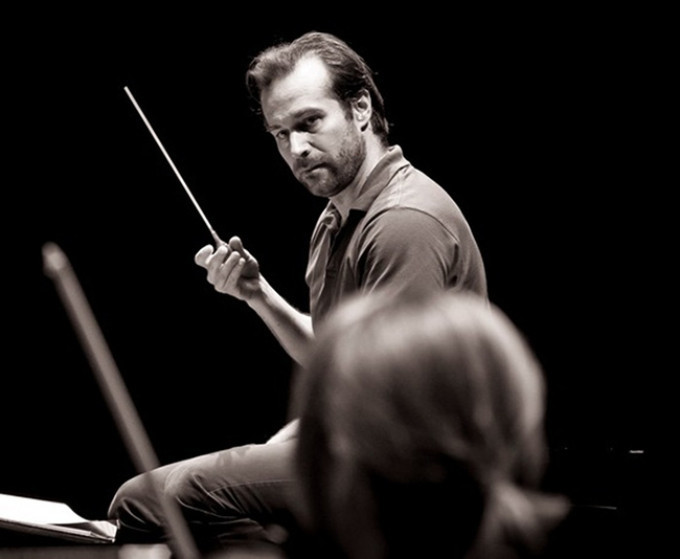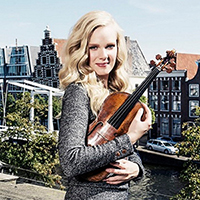Review: THE SAN DIEGO SYMPHONY CONDUCTED BY FABIEN GABEL at The Jacobs Music Center

The San Diego Symphony, along with many others, is this year celebrating the 100th anniversary of the birth of Leonard Bernstein. The first half of the Symphony's "Dances Suites and Serenades" concert consisted of "Three Dance Variations" from Bernstein's ballet Fancy Free, and Serenade (After Plato's "Symposium"). Fancy Free was choreographed by Jerome Robbins. Robbins collaborated on all of Bernstein's ballets and his hugely successful Broadway musical Westside Story. Fancy Free features Three Sailors on leave who want to impress two young women. Since two doesn't equal three, except possibly in fake-news reports, they dance to showoff and help the women decide which two suitors will win approval. Galop, waltz and danzon variations provide solos for each sailor in which to demonstrate skill and personality.
Conductor Fabien Gabel seemed to be imitating the sailors' moves, nearly leaving his feet at times in the exuberant galop, swaying romantically to the waltz, and moving with the Latin rhythms of the danzon. The orchestra responded in kind to make the perfect dance partner. It was a strong performance with an appropriately brash trumpet solo by Neal Berntsen and colorful, idiomatic percussion.
Bernstein's Serenade (After Plato's "Symposium") is one of the most immediately appealing of his more "serious" works. In five movements rather than the usual three, it was written for virtuoso Isaac Stern and features a solo violinist from beginning to end. What's in a name? I suspect it would be programmed more often if simply called Bernstein's violin concerto rather than the composer's intimidating preference. Soloist Simone Lamsma has a beautiful tone that projected clearly from the lowest notes to the highest airy harmonics, and her technique never failed, even in the exceptionally difficult third movement.
The Dutch-born violinist hasn't recorded enough to become a household name, but complimentary reviews of recent performances with the Cleveland, Chicago and Royal Concertgebouw orchestras, among others of the world's best, may change that. Bernstein's orchestration excludes woodwinds and brass and has few passages that might cause the solo line to be lost in the accompaniment. Still, the interplay between soloist and orchestra is tight and can go wrong. Maestro Gabel was in step with Lamsma throughout the performance. The final movement is the most eclectic. An orchestral introduction has a harshly modern sound. That soon gives way to a duet between violin and cello, a concert highlight in the warmly romantic version of Lamsma and Principal Cello Yao Zhao. The work concludes with rambunctious brio and echoes of Bernstein on Broadway.
complimentary reviews of recent performances with the Cleveland, Chicago and Royal Concertgebouw orchestras, among others of the world's best, may change that. Bernstein's orchestration excludes woodwinds and brass and has few passages that might cause the solo line to be lost in the accompaniment. Still, the interplay between soloist and orchestra is tight and can go wrong. Maestro Gabel was in step with Lamsma throughout the performance. The final movement is the most eclectic. An orchestral introduction has a harshly modern sound. That soon gives way to a duet between violin and cello, a concert highlight in the warmly romantic version of Lamsma and Principal Cello Yao Zhao. The work concludes with rambunctious brio and echoes of Bernstein on Broadway.
The concert's second half was friendly enough to be included in a future summer-pops program. (No, that's not a complaint.) I've never heard the San Diego Symphony Orchestra's strings sound more luscious than they were in Richard Strauss's Suite  from Der Rosenkavalier. And Principal Horn Benjamin Jaber and the section he leads played Strauss's stirring brass calls with heroic passion. Gabel's interpretation was solid except for an overdone hesitation intended to heighten anticipation of the rousing closing passages after the final gorgeous waltz.
from Der Rosenkavalier. And Principal Horn Benjamin Jaber and the section he leads played Strauss's stirring brass calls with heroic passion. Gabel's interpretation was solid except for an overdone hesitation intended to heighten anticipation of the rousing closing passages after the final gorgeous waltz.
If you need some cheering up, Jacques Offenbach is a go-to guy. Even the 19th Century critics who criticized him for a lack of depth acknowledged his exceptional melodic gift. In 1938 Manuel Rosenthal arranged many of the best tunes from Offenbach's roughly 100(!) operettas to create the Gaîté Parisienne ballet. While several of the operettas are still performed today, Offenbach is probably best known for suites based on Rosenthal's arrangements. Gabel programmed nine of the 19 ballet numbers including the "Infernal Galop," better known as the "Cancan," Offenbach's most familiar melody. His Gaîté Parisienne was lively and sparkling without neglecting the beauty of Offenbach's more romantic passages.
Photos courtesy of San Diego Symphony.
Reader Reviews

Videos

